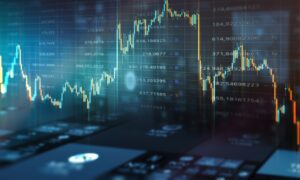
It was always much more than just a precious metal. It’s a secure haven in turbulent times, a trade instrument, and also an emblem of prosperity.
A favorite among institutional investors, portfolio managers as well as retail investors is gold futures. They let you benefit from price fluctuations and protect against the effects of inflation. Before you begin, it is important to be aware of how gold futures work as well as the risk involved and the strategies you can employ to remain ahead.
Are you looking to make better futures trading decisions? FundingTicks gives you the tools to examine markets in real-time to make educated decisions.
Let’s dive deeper into gold futures and what it takes to become a successful gold futures trader.
What Are Gold Futures?
Gold futures are contracts standardized that require the buyer purchase and sell gold at a specified price on a date in the future. These contracts are traded on central futures exchanges, such as COMEX.
As opposed to purchasing coins or gold bars, Futures contract trading doesn’t require physical ownership. Instead you speculate on the price that will be in the future of an asset. This gives more flexibility to traders on the short-term and eliminates the concerns about storage and insurance.
Gold futures aren’t identical to Gold ETFs, or mutual funds. These are contracts that offer traders with exposure to a tiny amount of capital. This makes them perfect for active and short-term traders who wish to earn rapidly from price fluctuations.
How Gold Futures Work
It is important to understand the nuances of gold futures before you make the first order. The standard contract is the equivalent of 100 troy ounces of gold. Micro and mini contracts which are 10 ounces or 1 ounce respectively, can also be purchased.
When you trade futures on gold you can either buy or sell them based on the price movement you expect to see. Here are the main components in gold-related futures
Leverage
Gold trading takes place by margin, which means that you only require just a small portion of the value of the contract as a deposit in order to trade. This allows you to manage an enormous trading position using less money, thereby increasing the profits and losses.
Expiration Dates
Every contract comes with a distinct expiration date. If you keep your position until the expiration date then it is either physically settled or settled with cash. The majority of traders will end their positions prior to expiration in order to avoid liquidation or transfer.
Margin Requirements
To purchase gold contracts it is necessary to make a small amount of money as a deposit for your initial margin. When you use the FundingTicks you won’t have to be concerned about this, since the prop company handles everything for you.
Gold futures are accessible to trade around the clock seven days a week. This gives traders the flexibility to trade across time zones.
Benefits of Trading Gold Futures
The many benefits of trading gold futures are attractive to both retail and institutional traders.
High Liquidity
Gold futures are among the most frequently traded contracts on international exchanges. Due to their large liquidity, spreads are extremely tight, and execution is swift which is crucial for traders who trade on a short-term basis.
Leverage for Enhanced Returns
In the future, you will be able to manage large-scale promotions using the use of a fraction of the capital. This can increase your profits in the event that your research is accurate. But, you could lose a substantial amount of money in the event of a miscalculation.
Hedging Tool
Gold futures can effectively protect against the effects of economic crisis, inflation, and currency appreciation. They are used by traders and institutions to safeguard their portfolios.
Portfolio Diversification
It is possible to diversify your risk with gold by adding futures to your portfolio. Gold is different from bonds and stocks, and provides uncorrelated returns, which reduces the risk overall.
Advanced Trading Opportunities
Futures traders are able to employ sophisticated strategies, like the use of pairs, spreads or arbitrage. They are not able to achieve gold investment strategies.
Risks and Challenges
However, despite the advantages, there are some dangers when trading futures contracts for gold.
Price Volatility
The price of gold is highly fluctuating. A change of $1 per ounce is equivalent to a $100 gain or loss in a typical gold contract. Price swings in the intraday market are typical because of news flow or geopolitics as well as technical changes.
Expiration Management
Futures contracts expire at a particular date. It’s risky to invest in positions with negative floating when they expire since your position could be automatically liquidated.
Psychological Pressure
Trading creates stress. Inexperienced decisions and repeated losses could affect your mental well-being.
Gold Futures vs Other Gold Investments
Let’s examine gold futures in comparison to three ways that you can invest in gold.
Gold ETFs
ETFs such as GLD monitor the price of gold, just as do stocks. They are simple to use and need the use of a futures account. But, they lack leverage, and they come with an administration fee.
Physical Gold
The purchase of gold bars or coins gives you tangible assets. This is a great option for long-term wealth preservation, but is not a good option for quick profits. Also, it comes with risks for security and the cost of transactions.
Gold Stocks
You can also invest in mining stocks, which offer an indirect exposure to the price of gold. They rise when the price of gold rises.
Gold Futures
Futures can be leveraged, provide liquidity, and 24/7 trading, making them ideal for traders who are active and able to profit from numerous opportunities in one day.
Do you need help in comparing trading systems? FundingTicks provides you with information on how gold futures are aligned with other assets and provide signals that you can take advantage of.
Best Strategies for Trading Gold Futures
The success of Gold Futures Trading is dependent on the strategy and plan you implement. Here are three strategies to consider:
Fundamental Analysis
Fundamental traders analyze the economic environment to forecast the direction of gold’s price. Important indicators include:
The Interest Rates It falls in gold when interest rates rise, and vice versa.
Inflation Information: Rising inflation pushes the price of gold up.
Geopolitical TensionsWars and uncertainty, as well as panic, chaos in the political arena and more. This will increase the demand for gold.
Central Bank Policy:Central banks’ monetary policies can have an impact. The policies of easing support the price of gold.
Technical Analysis
The majority of traders utilize charts or indicators as well as price actions to enter and exit. Common techniques include:
levels of Support and Resistance:These help find reversal or breakout zones.
Moving Averages and Trendlines:These reveal the overall movement and trend that the investment is experiencing.
MACD and RSI:These indicators tell whether gold is either overbought or undersold.
Risk Management
An effective strategy will be unusable without the management of risk.. Important rules include:
Always make sure to use stop-loss.
Do not take a risk that exceeds 1percent of your equity.
Review and record each trade to improve your method.
Conclusion
Futures trading in gold can be thrilling as well as risky when not handled by a professional with sufficient knowledge and plan. Before you begin, be aware of the market’s dynamics and be aware of your trading platforms as well as additional technical elements.
Are you ready to take your futures trading to the highest step? FundingTicks provides cutting-edge tools specifically for traders who trade in commodities and gold.
Read more:
Mastering Gold Futures: Key Strategies, Risks, and Opportunities






